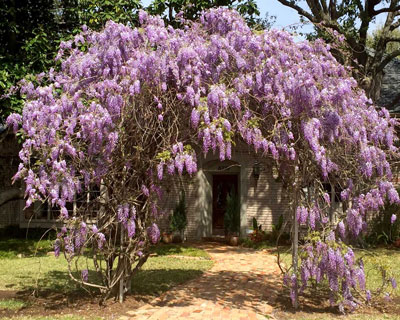Question of the Week – Number Two: April 5, 2018
“Neil, wisterias in our neighborhood have been blooming up a storm. Why does mine never flower?”
I get this question many times a month, especially at this time of the year. You’d think there might be one clear-cut answer, but unfortunately, there are several. I’ve often admitted that I think there are times when it’s a combination of two or three of the following possibilities.

Marcelle Borgers from Fort Worth shared this photo of her wisteria this week. (Thanks, Marcelle!) Oh, if they all could just bloom this well!
Why a wisteria might not produce flowers…
Here are the most common causes of wisterias not blooming.
• Too much shade. Like most flowering plants, wisterias bloom best when they’re in full or nearly full sun. However, vines that they are, they often clamber up into trees and across other supports that may contribute heavy shade to their surroundings. Heavy shade = light blooms.
• Pruned in winter. Like most spring-flowering shrubs and vines, wisterias produce their flowers on stem growth they made the preceding growing season. If we prune them in the winter, we’re cutting off much or all of those primordial buds. You must always prune wisterias and other spring-flowering shrubs and vines immediately after they finish blooming (or, should they fail to bloom, at the time when they would have finished blooming).
• Too much nitrogen. Many times we grow wisterias mixed in with our lawns. We apply nitrogen to the turfgrass in early September because we know how important that final fall feeding is to the health and vigor of the grass over the winter. But we forget that all that nitrogen may come at the expense of the production of flower buds on the wisteria shoots. As best you can, try to stay away from the wisteria’s root zones with your fall feeding.
• Perhaps the cuttings used to propagate the wisteria were taken from a “shy-blooming” plant. I’ve heard that suggested by some fine horticulturists – that perhaps an inferior strain has been perpetuated. However, nurserymen friends scoff at that by asking why anyone would think they would want more of a poorly blooming specimen. Personally, I lean to their side. I think it’s something else.
One thing you can do…
In addition to fixing the ills I’ve just described, there’s one other thing that might be of help. Try “root-pruning” your plant. It’s really quite simple:
• Use a sharpshooter spade.
• Do this work in early September.
• At a point 14 or 15 inches out from the trunk, cut a slit 8 to 10 inches deep to slice through the lateral roots. Do not attempt to cut the tap root or to lift the plant. You are merely cutting the lateral roots.
• You do this to shock the plant out of its strong vegetative growth. Their response often is a “survival of the species” in which they produce masses of flowers in an effort to yield seeds. It can’t hurt, and it might help!
